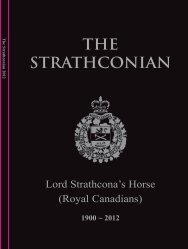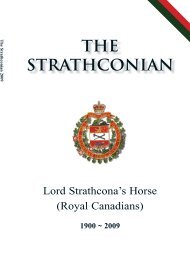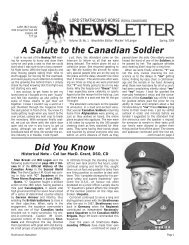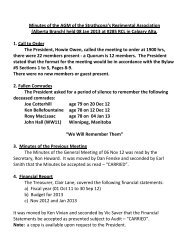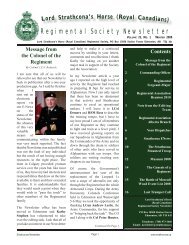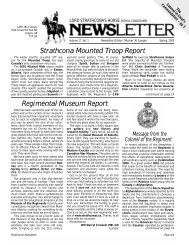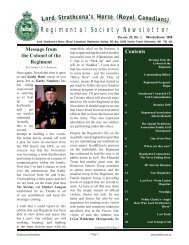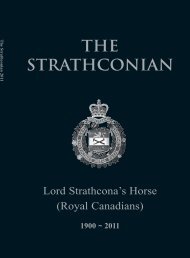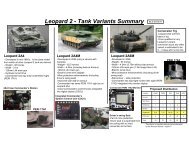The Regimental Manual Second Edition.pdf - Lord Strathcona's Horse
The Regimental Manual Second Edition.pdf - Lord Strathcona's Horse
The Regimental Manual Second Edition.pdf - Lord Strathcona's Horse
You also want an ePaper? Increase the reach of your titles
YUMPU automatically turns print PDFs into web optimized ePapers that Google loves.
REGIMENTAL MANUALHISTORY OF THE REGIMENTCHAPTER 1 - HISTORY OF THE REGIMENTARTICLE 1100 - THE BIRTH OF THE REGIMENT1. Alarmed by the frequency and the ease with which British foot soldiers were being defeated bymounted Boers in South Africa, Sir Donald A. Smith (<strong>Lord</strong> Strathcona and Mount Royal) offered, in1899, to raise and equip a mounted regiment of Western Canadians to fight in the campaign. <strong>Lord</strong>Strathcona, then the Canadian High Commissioner in London, believed that these ranchers, cowboys,prospectors, former members of the North West Mounted Police, and the like, who were born and bred tothe saddle, able to shoot and live off the land would be a match for the Boers. His offer to form such aunit was eagerly accepted. Uniquely, the Regiment was raised as a unit of the Imperial Army and not ofthe Dominion of Canada, as was the case with all the other units of the Canadian contingents.2. <strong>The</strong> responsibility of forming the Regimentwas given to Superintendent Samuel B. Steele of theNorth West Mounted Police. On 26 January 1900 <strong>Lord</strong>Strathcona approved Steele’s, now a LieutenantColonel and the Regiment’s first Commanding Officer,suggestion that the Regiment be named “Strathcona’s<strong>Horse</strong>.” On 1 February 1900, the unit was formallyauthorized under Militia Order Number 26/00. 1 By 25February, Lieutenant-Colonel Steele had completed theorganization and on 16 March, 28 Officers and 512other ranks with 599 horses of Strathcona’s <strong>Horse</strong>sailed from Halifax on the Elder Dempster Liner, H.M.Transport, “Monterey” bound for South Africa.3. <strong>The</strong> Regiment arrived in Cape Town on 10April 1900 after a voyage that was marked by the deathof 161 horses. Lieutenant-Colonel Steele immediatelybegan training the Regiment in the climate and terrainof South Africa. A month later, orders were receivedfor Strathcona’s <strong>Horse</strong> to proceed to the east coast ofSouth Africa by sea and then inland to blow up a bridgeand cut Boer communications to the sea. On 2 June theBritish discovered that the Boers had learned of theplans and the Regiment was withdrawn to Durban. Figure 1 – H.M. Transport Monterey, 16 March 1900(<strong>Regimental</strong> Museum Archives)4. Strathcona’s <strong>Horse</strong> joined the 3 rd Mounted Brigade in Natal on 20 June 1900 and took part inGeneral Buller’s pursuit of the Boers into the Transvaal. Employed as scouts for the advancing army, theRegiment was often the first to make contact with the enemy and therefore suffered numerous casualties.5. <strong>The</strong> spirit of Strathcona’s <strong>Horse</strong> in South Africa can best be illustrated by recounting the episodein which Sergeant A.H. Richardson earned the first Victoria Cross awarded to a member of a Canadianunit. On 5 July 1900, at Wolver Spruit, a party of Strathcona’s <strong>Horse</strong> was ambushed by a group of Boers.Corporal A. McArthur was wounded and fell from his horse. Sergeant Richardson, seeing that the manwas in danger of being taken prisoner, retrieved him, threw him across his saddle, and rode off under a1 Militia Order 26/1900, 1 February 1900: <strong>The</strong> order was issued for the formation of a mounted corps for special service in SouthAfrica. <strong>The</strong> authorized strength was 42 officers, 504 non-commissioned officers and men, and 548 horses.1-1



